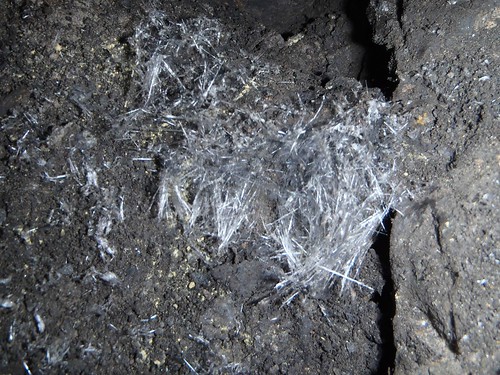Thought I had...interested in thoughts/ideas from those in research...
I still have yet to find a stable research job. But I am trained, degreed, etc. Why not do my own research (I have done some already, see the phos thread I started, but what I did was cheap and easy....this...wouldn't be).
There is a cave locally. I have observed over the past two years that in one area there is delicate gypsum formation, what we call gypsum snow, that coats the rocks and walls, however, it comes and goes. This particular cave sucks air in the winter, bringing in the cold outside air, and lowering the cave air temp in the coldest months (around freezing to about 5c) and changing the airflow. This is when the gypsum snow forms. The wamer months this cave blows air, so the cave air temp is higher (about 14c) and the current is obviously different since it's blowing not sucking. In these warmer months, there is no gypsum snow. It vanishes. Only to return the next winter.
Seems a perfect longterm study....I'm thinking about applying for a grant to study it. I think I can get permission from the cave owner as they are very caver friendly so that shouldn't be an issue. Figure I'd need to monitor ambient air temperature, air flow (direction and velocity, it's not called a blowing hole for nothing, it can pelt it!), and humidity. Perhaps barometric pressure too? I know there are devices for recording these things, would have to set it up for daily readings. Visit the cave often, esp when the readings change, which mean I need some sort of remote access to the readings. However there is no wifi nor cell signal at the entrance so I'm not sure how that would work.
Thoughts? Method suggestions? funding source ideas (my only idea is the NSS does offer some grant funding here and there). Equipment suggestions?
I still have yet to find a stable research job. But I am trained, degreed, etc. Why not do my own research (I have done some already, see the phos thread I started, but what I did was cheap and easy....this...wouldn't be).
There is a cave locally. I have observed over the past two years that in one area there is delicate gypsum formation, what we call gypsum snow, that coats the rocks and walls, however, it comes and goes. This particular cave sucks air in the winter, bringing in the cold outside air, and lowering the cave air temp in the coldest months (around freezing to about 5c) and changing the airflow. This is when the gypsum snow forms. The wamer months this cave blows air, so the cave air temp is higher (about 14c) and the current is obviously different since it's blowing not sucking. In these warmer months, there is no gypsum snow. It vanishes. Only to return the next winter.
Seems a perfect longterm study....I'm thinking about applying for a grant to study it. I think I can get permission from the cave owner as they are very caver friendly so that shouldn't be an issue. Figure I'd need to monitor ambient air temperature, air flow (direction and velocity, it's not called a blowing hole for nothing, it can pelt it!), and humidity. Perhaps barometric pressure too? I know there are devices for recording these things, would have to set it up for daily readings. Visit the cave often, esp when the readings change, which mean I need some sort of remote access to the readings. However there is no wifi nor cell signal at the entrance so I'm not sure how that would work.
Thoughts? Method suggestions? funding source ideas (my only idea is the NSS does offer some grant funding here and there). Equipment suggestions?





